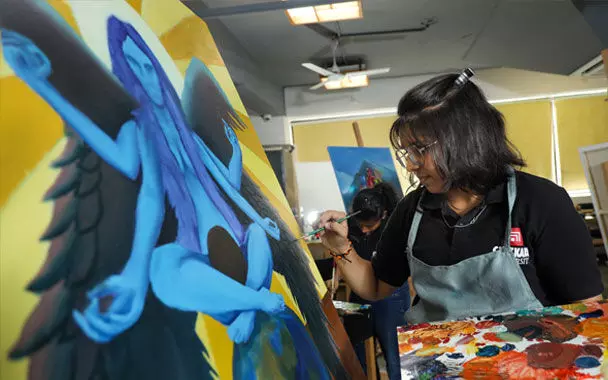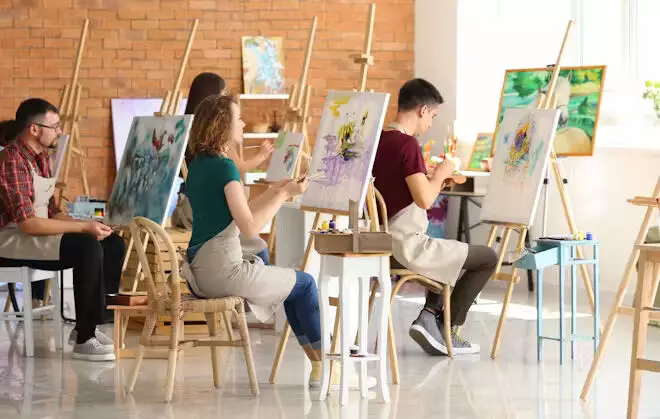The Role of Assam Central University’s Visual Arts Department

Aditi Deka Pathak
Art is a potent medium that unites history, identity, and creation, bridging the past and present. The Visual Arts Department of Assam Central University is a crucial identity promoting this relationship, encouraging the development of local culture and motivating upcoming generations of artists and academics. The department is essential to preserving Assam's and Northeast India's rich artistic legacy through its educational programs, research projects, and community involvement.
Numerous indigenous civilisations, artistic traditions, and visual storytelling may be found in northeastern India. Because of the significance of maintaining this history, Assam Central University, Silchar's Department of Visual Arts was established as a pioneering centre for scholarly and cultural accomplishment. The Department of Visual Arts at Assam Central University has made a substantial contribution to the regional development, cultural preservation, and art promotion of Northeast India since its establishment in 1996. Through planned academic programs, community service, and research projects, the department has grown into a hub for encouraging creativity, documenting traditional arts, and raising cultural awareness. The department began with a four-year Bachelor of Visual Arts (BVA) degree and expanded to include Master of Visual Arts (MVA) and Ph.D. programs with applied art, painting, sculpture etc.
The Visual Arts Department is actively involved in cultural development projects outside of campus. Exhibitions, workshops, and joint ventures with regional craftspeople and communities promote a conversation between tradition and academia. These initiatives support the revival of dying art forms and open up new doors for local artists.
The department also promotes greater understanding and support for Assam's rich cultural heritage by hosting art festivals and public exhibitions. By connecting art education to social empowerment and the creation of regional identity, this community-oriented approach supports the university's larger developmental objectives.
It was the first of its sort in the region to offer structured arts programs, including bachelor's, master's, and doctoral degrees. It explores the department's importance and its contributions to art, cultural preservation, and regional growth. The department shapes the region's cultural future by serving as an essential training ground for future scholars, lecturers, and artists. Classes combine classic techniques in painting, sculpture, and applied arts with teaching in modern media, such as computer design, video art, and installation art. This multidisciplinary approach keeps the curriculum up to date and competitive on a global basis.
The department has extensively documented tribal and folk art forms, especially from South Assam, including painting, sculpture, terracotta, textiles, and regional crafts. This endeavour ensures the conservation and academic study of fragile and dwindling traditions. Through the staging of art exhibitions, history walks, and workshops led by artisans, the department promotes intergenerational cultural exchange and reignites the interest of younger generations in traditional creative forms.
In Assam and the neighbouring states, people engage in a wide range of artistic pursuits, including folk painting, weaving, ceramics, and carpentry. The department is crucial to the documenting, interpretation, and preservation of these traditions, many of which had not previously been recorded in scholarly settings. Through the use of digital art, video installations, mixed media, and experimental techniques, the department blends the traditional and the modern. This keeps the curriculum up to date and ensures that students are ready to participate in national and international art forums.
Through fieldwork and academic research, the department has documented a number of traditional customs from South Assam, the Barak Valley, and tribal areas. The department frequently organises workshops, exhibitions, historical awareness programs, and craft demonstrations with local artisans. The department indirectly supports economic growth by promoting cultural businesses and historic tourism. Its outreach programs foster long-term cultural lives and elevate local artisans.
The Assam Central University Visual Arts Department's future goals include: Establishing a museum and visual arts archive to preserve regional art forms; strengthening interdisciplinary and digital collaborations; expanding global academic and cultural partnerships; and offering short-term training courses and certification to artists and art enthusiasts in rural areas.

The Department of Visual Arts at Assam Central University is the catalyst for the cultural and educational transformation of Northeast India. Because of its initiatives to uplift local communities, support traditional and modern art forms, and foster cultural research, it is a crucial organisation for long-term cultural development. As the region grapples with the challenges of modernisation and globalisation, the department remains a crucial site for preserving artistic identity while encouraging innovation.
The Department of Visual Arts at Assam Central University is a vital institution for promoting the artistic heritage, cultural identity, and creative education of Northeast India. Its work not only fosters artistic talent but also promotes cultural preservation and regional development.
Three prominent authors from the Visual Arts department are Prof. (Dr.) Nirmal Kanti Roy, Dr. Rajkumar Mazinder, and Dr. Ganesh Nandi. Professor Roy's work, "Signification System in Indian Advertising," offers a critical semiotic analysis of Indian advertising and is a reflection of his substantial research on visual communication and cultural sign systems. "Shilpakala: Oitihya Aru Adhunikata," Dr. Rajkumar Mazinder's landmark work in Assamese, delves into the history and modern facets of visual arts, particularly within the Assamese context. However, "Charukalai Barak: Itihas O Samakal," written by Dr. Ganesh Nandi, provides a comprehensive historical and contemporary examination of the visual arts in the Barak Valley, illuminating the region's unique cultural evolution.


